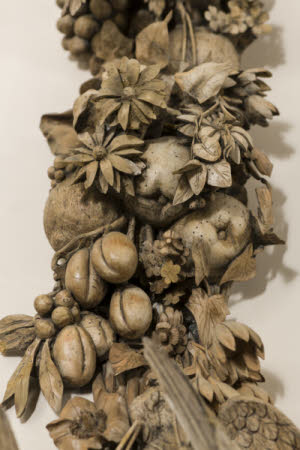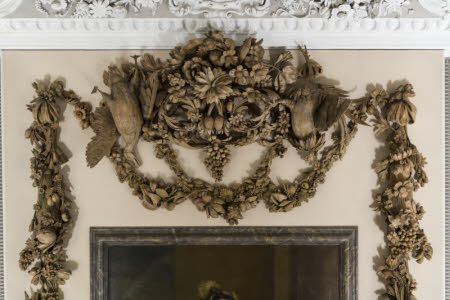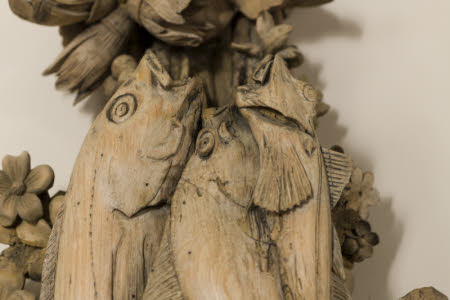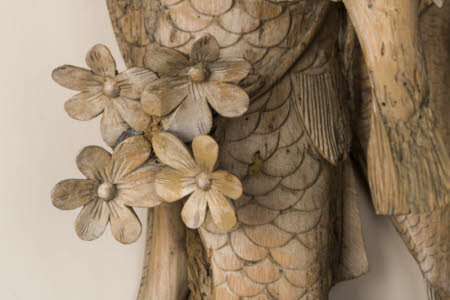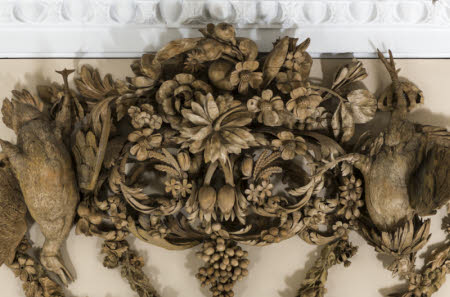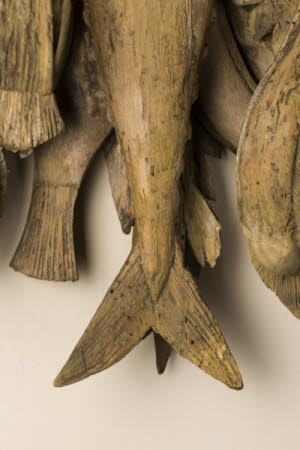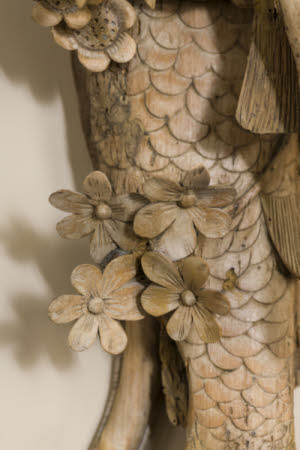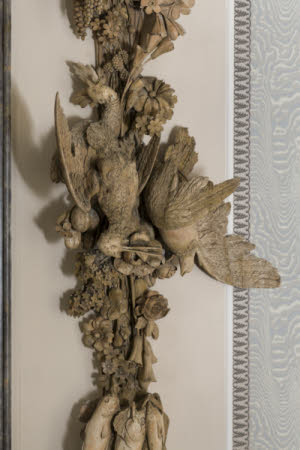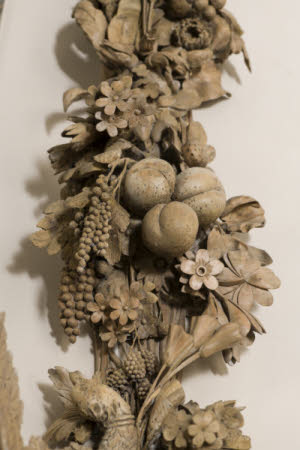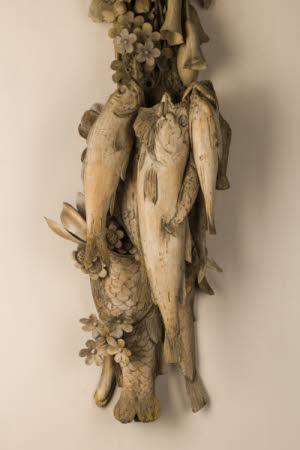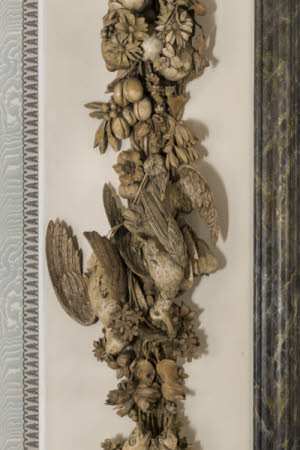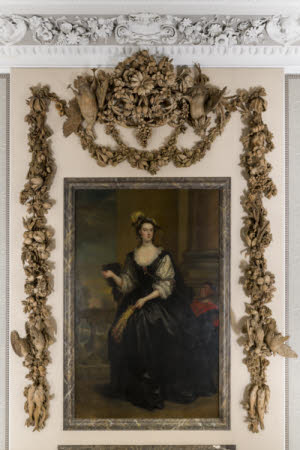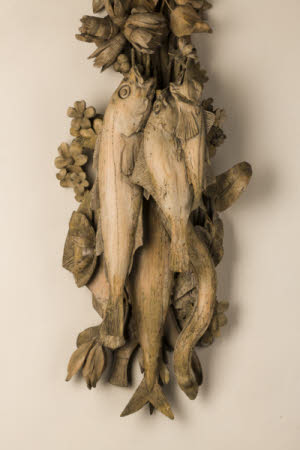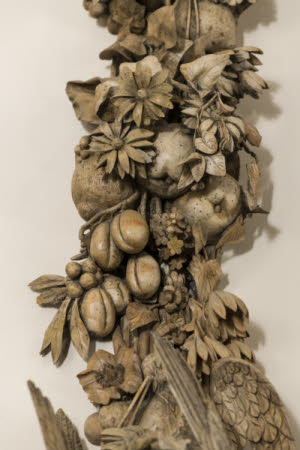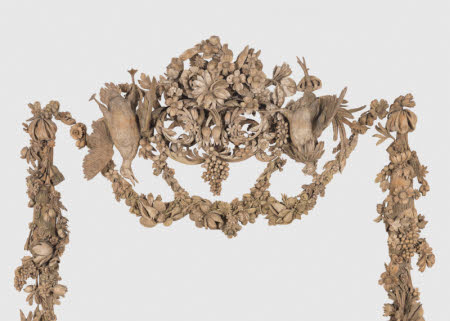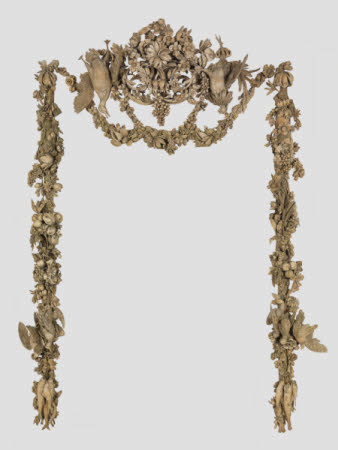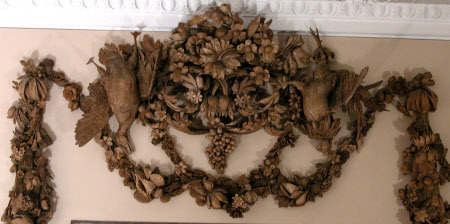Overmantel
Grinling Gibbons (Rotterdam 1648 - London 1721)
Category
Art / Sculpture
Date
1678
Materials
Carved limewood
Measurements
345.4 x 182.9 cm
Place of origin
England
Order this imageCollection
Sudbury Hall (Children's Country House), Derbyshire
NT 652745
Caption
The artist and wood-carver Grinling Gibbons (1648–1721) specialised in an amazing sculptural carving technique that brought together natural forms of fruit, flora, foliage, dead game birds and other animals to create elaborate wall decorations. The effect was to combine the lavish abundance of nature with a symmetrical design, providing an ideal of order as brought about by the human hand. His designs were perfectly suited to a country-house setting, where parties of guests could relax following hunting or other outdoor pursuits. Gibbons trained in the Netherlands, and his work was particularly fashionable for period interiors in the later 17th century. The use of limewood, a soft and easily worked material with little grain, meant that, following in a tradition established in the Middle Ages, Gibbons could carve deep, elegant forms in a high level of detail. This design was commissioned by George Vernon (1635–1702), the owner of Sudbury Hall in Derbyshire, and can be seen in the house today.
Summary
A carved limewood overmantel, by Grinling Gibbons (1648-1721) and his workshop, 1678. Comprising a central section and two adjacent drops. The former centred by an abundant spray of naturalistic flowers, leaves and pendant bunches of grapes flanked by a trussed duck and a chicken. A triple-swag garland of flowers, leaves and shells joining the two drops, both carved with flowers and leaves and to their lower thirds with hung game-birds and fish.
Full description
Gibbons’s Drawing Room overmantel of a cresting with adjacent drops was commissioned in 1678 at a cost of £40 by George Vernon (1635-1702), the builder of Sudbury. This form of carved decoration became Gibbons’s trademark, allowing maximum scope for inventive design, incorporating finely observed and beautifully carved flora and fauna, deeply undercut to obtain the maximum sculptural effect. The concept derives from Antiquity: swags, festoons and drops of carving were useful to frame and enhance both interior and exterior architecture. In the hands of early-seventeenth-century neo-Classicist architects and designers, such carving, however rich, was subject to strict symmetry. The pair of drops flanking a central cresting, as in Gibbons’s overmantel, would be identical. This approach can be seen at Sudbury in the tripartite overmantel and overdoor carvings in the Saloon, where Edward Pierce’s work, executed in the same year as Gibbons’s Drawing Room overmantel, is beautiful and inventive, combining garlands tied with ribbons, but rigidly symmetrical. Compare Gibbons’s approach to the same problem: first, the cresting is much larger, pressing into the plaster cornice to give more height and to endow the composition with Baroque surprise and movement. Flowers and grapes are executed in the round, while the central concentration of carving is flanked by a duck and a chicken, one wing hanging down, with legs trussed as in a game larder. A complex arrangement of intertwined garlands connects the centrepiece cresting carvings to the drops at either side. Each drop balances the other in terms of weight and outline, but this superficial symmetry belies the ambitious variety with which Gibbons approaches them. Flora and greenery dominate until the last two tiers of the carvings at the base of the garlands, where fowl and fish take over. Gibbons’s Sudbury commission anticipates the magnificent tours de force of the double crestings and drops in his masterpiece on a grand scale, the Carved Room at Petworth. This dates from the 1690s by which time Gibbons was experimenting obsessively with drawings depicting chimneypieces and carved overmantels, a series now mainly in Sir John Soane’s Museum, London.
Provenance
At Sudbury since 1678 and by descent; the Vernon collection was transfered from H.M. Treasury to the National Trust on the 30 October 1984.
Makers and roles
Grinling Gibbons (Rotterdam 1648 - London 1721), carver
References
Esterly, 1998: David Esterly, Grinling Gibbons and the Art of Carving, exh. cat. (The Victoria and Albert Museum, London), London 1998, pp. 78, 82-4, 90, 177-8, 183-4, front cover
